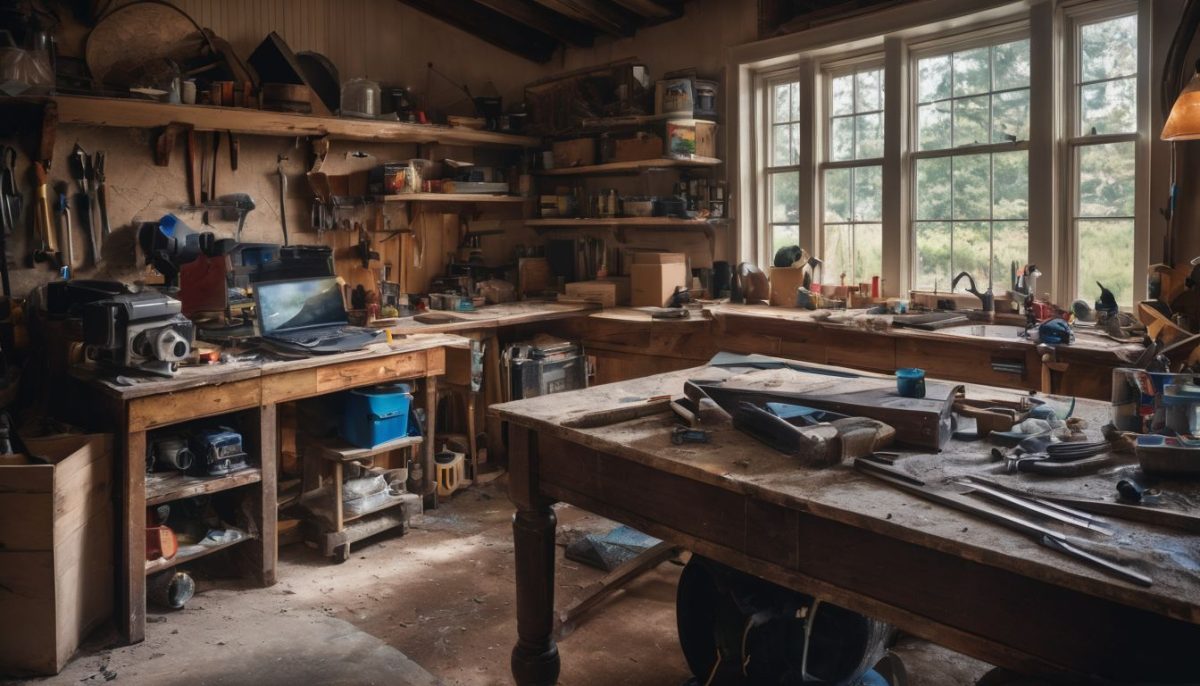Struggling to borrow money with a not-so-great credit score can feel like hitting a wall.
A home equity loan might be the key, using your house as financial leverage. This guide lays out the steps you need to take to snag that loan even when your credit isn’t shining bright.
Read on to find out how to get a home equity loan with bad credit.
Key Takeaways
- Even with bad credit, getting a home equity loan is possible by finding specialized lenders and showcasing stable income, employment, and substantial home equity.
- To improve your credit score before applying for a home equity loan, pay down debts, keep credit card balances low, maintain old lines of credit open for a longer credit history, and be patient while working consistently towards better financial habits.
- The amount you can borrow with a home equity loan depends on your home’s market value and mortgage balance. Typically, you can tap into up to 85% of your home’s equity.
- Repairing your credit score requires time through regular payments on debts and careful financial management; watching out for errors on your report also helps in improving the score faster.
- Before deciding on a home equity loan with bad credit, carefully weigh its pros and cons considering personal financial goals; obtaining advice from financial experts ensures informed decision-making.
What is a home equity loan?
A home equity loan lets you borrow against the value of your house. It works like this: First, appraisers determine how much your home is worth. Then lenders look at how much you owe on your mortgage to figure out the difference, which is called equity.
You can loan yourself a portion of that equity and receive it as a lump sum of cash.
This type of loan usually comes with a fixed interest rate, meaning monthly payments stay the same for the entire term of the loan. Homeowners often use these loans for big expenses such as home renovations or paying off high-interest debts.
Just be sure to consider all your options carefully. #ith a home equity loan, your house serves as collateral. If you can’t make payments on time, there’s a risk you could lose your home.
With an understanding of what a home equity loan entails, let’s explore whether bad credit affects your chances of getting one and what steps are available to improve credit scores if necessary.
Pros and cons of home equity loans
Understanding what a home equity loan is lays the foundation for weighing the advantages and disadvantages of this financial tool. Home equity loans can be a powerful means to access cash, but they’re not without their trade-offs.
| Pros | Cons |
| Potentially lower interest rates compared to other loans | Risk of foreclosure if you can’t repay the loan |
| Fixed repayment terms can provide structure | Possibility of reduced equity or negative equity |
| The interest may be tax-deductible | Closing costs and potential fees can add up |
| Lump-sum funding provides financial flexibility | Impact on your credit score if you borrow too much |
| Ability to consolidate debt under a lower rate | Requires substantial home equity to qualify |
| Fixed interest rates offer predictable payments | Long-term commitment that may outlast the usefulness of the funded need |
Can I get a home equity loan with bad credit?
Getting a home equity loan with bad credit isn’t impossible, but it does come with challenges. Lenders typically check your credit score to determine risk before approving a loan. A low score might make them hesitant since it indicates past financial struggles.
However, some lenders specialize in loans for those with less-than-perfect credit and may offer you a deal, though usually at higher interest rates to offset the increased risk they’re taking on.
If your credit is poor, consider seeking out these specialized lenders or improving your eligibility by demonstrating strong income and stable employment. Additionally, showing that you have considerable equity in your property can help persuade lenders that you’re worth the risk because it means there’s more at stake for you, too.
Preparing detailed documentation of all these factors can significantly improve the odds of getting approval for a home equity loan despite having bad credit.
Tips on improving your credit score
To improve your credit score, start by paying off debt and minimizing credit card utilization. Keeping old credit cards open and being patient and determined will also help in the long run.
Pay off debt
Eliminating outstanding debts can significantly improve your credit score, making you a more attractive candidate for a home equity loan. Prioritize paying off high-interest loans and credit card balances to reduce your overall debt load.
By doing so, you’ll demonstrate financial responsibility and increase the likelihood of securing a favorable loan.
Consistently chipping away at your debt will demonstrate discipline and commitment to potential lenders, setting the stage for a successful home equity loan application. Making regular payments on time will boost your creditworthiness, ultimately putting you in a better position to secure the loan amount you need.
Minimize credit card utilization
To improve your chances of getting a home equity loan with bad credit, it’s crucial to minimize credit card utilization. This means keeping your credit card balances low in relation to your overall credit limit.
Aim to use no more than 30% of the available balance on each card. Doing so can positively impact your credit score and demonstrate responsible financial management.
Reducing credit card utilization can help lower your overall debt-to-income ratio, which lenders consider when evaluating loan applications. By cutting down on spending and paying off existing balances, you’ll show potential lenders that you’re committed to managing your finances wisely and are less of a risk.
Keep old credit cards open
If you’re looking to improve your credit score, it’s essential to consider the benefits of keeping old credit cards open. This tactic can positively impact your credit utilization ratio and overall credit history.
By maintaining these accounts, you demonstrate a longer credit history, which can enhance your credibility as a borrower. Additionally, these cards contribute to a higher total available credit limit, helping reduce your overall credit utilization ratio.
Keeping old cards active but lightly utilized showcases responsible financial management to potential lenders.
Be patient and determined
Improving your credit score takes time and effort. Pay off debt, minimize credit card utilization, and keep old credit cards open. It’s crucial to be patient and determined throughout this process.
With consistent efforts, you can gradually see positive changes in your credit score, leading to better chances of getting approved for a home equity loan.
Maintaining patience is key when working on your credit score. Set small milestones to stay motivated and focused on improving your financial standing. Stay determined in managing your finances responsibly as it will eventually pave the way for obtaining a home equity loan with favorable terms despite a bad credit history.
Home equity loan with bad credit: FAQs
Here are some of the most common questions we’re hearing about home equity loans, along with their answers.
Can I get a home equity loan with bad credit?
While it’s possible to get a home equity loan with bad credit, it may be challenging. Lenders often consider factors such as your income, employment history, and the amount of equity you have in your home.
Despite having a low credit score, demonstrating financial stability and sufficient home equity can increase your chances of approval.
If you’re determined to pursue a home equity loan with bad credit, consider seeking professional advice from mortgage specialists familiar with working with borrowers in similar situations.
They can provide tailored guidance on improving your chances of securing a loan while managing the potentially higher interest rates associated with bad credit.
How much can I take out with a home equity loan?
With a home equity loan, the amount you can borrow is determined by the difference between your home’s current market value and the balance on your mortgage. Generally, you can access up to 85% of your home’s equity, but this varies depending on the lender.
Remember that other factors such as your income, credit score, and debt-to-income ratio also play a role in determining how much you can borrow.
Understanding how much you can take out with a home equity loan is crucial when considering this option for financing. It’s important to weigh all these factors carefully before reaching a decision.
How fast can I repair my credit score?
Improving your credit score takes time and consistency. By paying off debt, minimizing credit card utilization, and keeping old credit cards open, you can start to see positive changes in your credit score over several months.
It’s important to be patient and determined during this process. Additionally, regularly monitoring your credit report for any errors or inaccuracies can help expedite the repair of your credit score.
To repair your credit score quickly, focus on making timely payments and reducing outstanding debt. Consistently practicing good financial habits will gradually improve your creditworthiness, opening up opportunities such as obtaining a home equity loan despite earlier setbacks with bad credit.
Should you get a home equity loan?
Before applying for a home equity loan, consider the long-term financial implications. Assess your ability to make timely repayments and evaluate if taking on additional debt aligns with your financial goals.
It’s essential to weigh the benefits against the risks and explore alternative financing options that may better suit your current situation.
Before committing to a home equity loan, consult with a qualified financial advisor to fully understand the impact it could have on your overall financial health. Taking proactive steps towards informed decision-making will put you in a good place to achieve your homeownership dreams while safeguarding your long-term financial stability.
Home equity loan with bad credit: More FAQs
1. Is it possible to get a home equity loan with bad credit?
Yes, getting a home equity loan with bad credit is possible but may come with higher interest rates.
2. What can I do to improve my chances of getting a home equity loan when I have bad credit?
To improve your chances, try to lower your debt-to-income ratio and check if you have enough home equity built up.
3. Will having a co-signer help me get a home equity loan if I have bad credit?
Having a co-signer with good credit can increase the likelihood of being approved for a home equity loan.
4. Can paying off debts improve my credit score before applying for a home equity loan?
Paying off debts can help raise your credit score over time which might make it easier to qualify for the loan.
5. How long does it typically take to get approved for a home equity loan with poor credit?
The approval process timeline varies by lender but may take longer if additional documentation is required due to poor credit.
To find out whether a home equity loan is the right financial vehicle for you, connect with an experienced financial advisor.
Disclaimer:
The content provided on this website is offered for educational purposes only. While we endeavor to provide accurate and up-to-date information, we make no representations or warranties of any kind, express or implied, about the completeness, accuracy, reliability, suitability, or availability of the content for any purpose. Visitors are advised to consult with qualified experts before making any financial decisions or taking any actions based on the information provided on this website.














